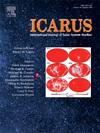Modeling barometric pumping of martian methane: Implications for Perseverance sample timing and gas loss from drilled cores
IF 3
2区 物理与天体物理
Q2 ASTRONOMY & ASTROPHYSICS
引用次数: 0
Abstract
There are many challenges surrounding the interpretation of martian methane signatures. Atmospheric methane variations detected by the Sample Analysis at Mars (SAM) instrument on board the Curiosity rover remain difficult to explain given the lack of a confirmed methane transport mechanism from subsurface sources. Furthermore, the biogenic or abiogenic origin of martian methane cannot be determined outside of isotopic analysis in an Earth-based laboratory. Building on our previous work modeling barometrically driven seepage of methane through fractured rock coupled to a simplified atmospheric mixing scheme, we now use the same model framework to estimate the methane concentration in the shallow subsurface. Our results indicate that subsurface methane levels also exhibit strong seasonal and diurnal variability, with peak concentrations occurring during specific windows of time that depend on both solar and atmospheric forcing.
This insight has implications beyond Gale crater. At Jezero crater, where the Perseverance rover is collecting samples for potential return to Earth, strategic selection of sampling times could enhance the chances of recovering methane-bearing rock. Our results suggest that the timing of sample collection – both time of day and time of year – can significantly affect the likelihood of capturing methane within the collected cores if barometric pumping is a significant driving factor. Sample timing optimization could increase the potential for detecting organics or signatures of habitability in Mars Sample Return, augmenting the overall scientific return of the Mars 2020 mission and possibly bringing us closer to understanding the origin of methane on Mars. However, a preliminary analysis of methane loss rates from collected samples indicate that unless sample tubes can be sealed within a few hours of collection, the majority mass fraction of methane is likely to escape.
模拟火星甲烷的气压泵:毅力样本时间和钻探岩心气体损失的含义
火星甲烷特征的解释面临着许多挑战。好奇号火星车上的火星样本分析(SAM)仪器检测到的大气甲烷变化仍然难以解释,因为缺乏来自地下来源的甲烷运输机制的确认。此外,火星甲烷的生物或非生物起源不能在地球实验室的同位素分析之外确定。在我们之前的工作的基础上,我们模拟了由气压驱动的甲烷通过裂隙岩石渗漏,并结合了一个简化的大气混合方案,我们现在使用相同的模型框架来估计浅层地下的甲烷浓度。我们的研究结果表明,地下甲烷水平也表现出强烈的季节和日变化,峰值浓度出现在特定的时间窗口,这取决于太阳和大气强迫。这一发现的意义超出了盖尔环形山。在耶泽洛陨石坑,“毅力”号探测车正在收集样本,以便有可能返回地球,策略性地选择采样时间可以提高回收含甲烷岩石的机会。我们的研究结果表明,如果气压泵是一个重要的驱动因素,那么样品收集的时间——一天中的时间和一年中的时间——可以显著影响在收集的岩心中捕获甲烷的可能性。样本时间优化可以增加在火星样本返回中探测有机物或可居住特征的潜力,增加火星2020任务的整体科学回报,并可能使我们更接近了解火星上甲烷的起源。然而,对收集样品的甲烷损失率的初步分析表明,除非样管能在收集后的几个小时内密封,否则大部分甲烷很可能会逸出。
本文章由计算机程序翻译,如有差异,请以英文原文为准。
求助全文
约1分钟内获得全文
求助全文
来源期刊

Icarus
地学天文-天文与天体物理
CiteScore
6.30
自引率
18.80%
发文量
356
审稿时长
2-4 weeks
期刊介绍:
Icarus is devoted to the publication of original contributions in the field of Solar System studies. Manuscripts reporting the results of new research - observational, experimental, or theoretical - concerning the astronomy, geology, meteorology, physics, chemistry, biology, and other scientific aspects of our Solar System or extrasolar systems are welcome. The journal generally does not publish papers devoted exclusively to the Sun, the Earth, celestial mechanics, meteoritics, or astrophysics. Icarus does not publish papers that provide "improved" versions of Bode''s law, or other numerical relations, without a sound physical basis. Icarus does not publish meeting announcements or general notices. Reviews, historical papers, and manuscripts describing spacecraft instrumentation may be considered, but only with prior approval of the editor. An entire issue of the journal is occasionally devoted to a single subject, usually arising from a conference on the same topic. The language of publication is English. American or British usage is accepted, but not a mixture of these.
 求助内容:
求助内容: 应助结果提醒方式:
应助结果提醒方式:


